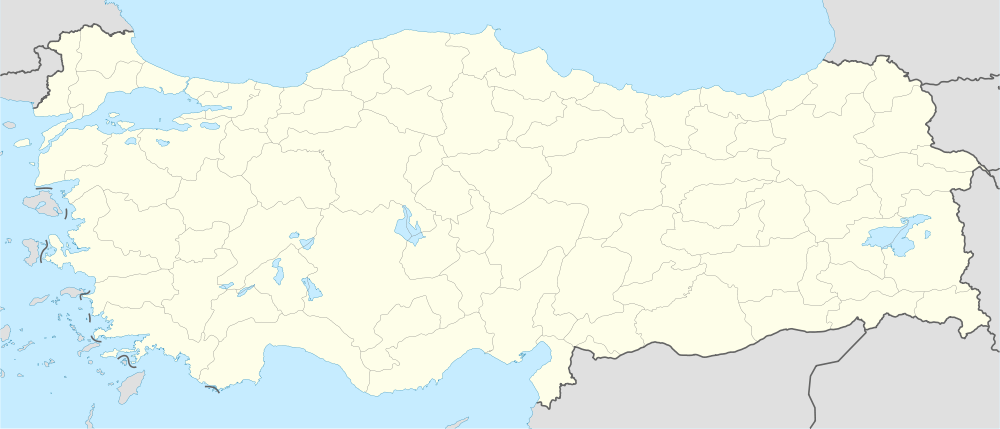Kıyıköy
| Kıyıköy | |
|---|---|
| Village | |
 Kıyıköy Location in Turkey | |
| Coordinates: 41°38′07″N 28°05′46″E / 41.63528°N 28.09611°ECoordinates: 41°38′07″N 28°05′46″E / 41.63528°N 28.09611°E | |
| Country |
|
| Region | Marmara |
| Province | Kırklareli Province |
| District | Vize |
| Municipality | 1987 |
| Government | |
| • Mayor | İsmail Gök (CHP) |
| Population (2010)[1] | |
| • Total | 2,077 |
| Time zone | EET (UTC+2) |
| • Summer (DST) | EEST (UTC+3) |
| Postal code | 39480 |
| Area code(s) | 0 288 |
| Licence plate | 39 |
| Website |
kiyikoy |
Kıyıköy, formerly Midye, ancient/medieval Medea (Greek: Μήδεια), is a village in the district of Vize in Kırklareli Province at northwestern Turkey. It is situated on the coast of the Black Sea. It is 36 km (22 mi) far from the district center and 95 km (59 mi) away from the province center. The village became a municipality in 1987. The population of Kıyıköy is 2,077 according to the 2010 National Census.[1]
Fishing and forestry are the main ways of living in addition to tourism in the summer. The town has a small beach. The area surrounding the town is covered by dense forests of mainly oak. Two streams, Kazandere and Pabuçdere, surround the town in the south and the north respectively. Flowing into the Black Sea, these streams are suitable for fishing, boating and swimming.
The Kasatura Bay Nature Reserve Area is 18 km (11 mi) south of the town along the Black Sea. The site harbors a pristine forest and a beach. The only naturally growing grove of black pine (Pinus nigra) in the European part Rumelia of Turkey is found at this site.
Medea is a Roman Catholic titular see[2]
In mythology
Kıyıköy is identified with Salmydessus,[3] where in Greek mythology the Argonauts rescued Phineus from the Harpies.[4]
History
In the near past, Kıyıköy was occupied by Imperial Russian troops after the Russo-Turkish War (1877–1878), and later by Bulgarians and Greeks following the Balkan Wars (1912-1913). At a time, the borderline of the Ottoman Empire to the west was passing through the town, and was called "Midye-Enez Line" (Turkish: Midye-Enez Hattı) as its name was still Midye.[5]
In the frame of population exchange between Greece and Turkey that took place in 1923, the mostly Greek and Bulgarian ethnicity residents of the town were replaced by Turks from Thessaloniki in Greece because of their wide knowledge of maritime matters.[5]
In 1960, the settlement's name was changed from Midye to Kıyıkent assuming the former is a foreign language name.[5]
Places of interest
St. Nicholas' Monastery (Turkish: Aya Nikolas Manastırı) (Greek: Μονὴ τῆς Άγιος Νικόλαος) is a Byzantine era Orthodox monastery, built during the time of Emperor Justinian I (reigned 527-565). It is situated about 800 m (2,600 ft) southwest of the town. The monastery consists of a chapel at the ground floor, cells for the monks and storerooms. In the basement, there is a holy well (hagiasma) (Turkish: ayazma) (Greek: ἁγίασμα). The monastery was constructed entirely by cutting into a massive rock. It is known that the monastery was renovated in 1856 by Metropolitan bishop Matthaios, who built also a wooden annex in front of the monastery, which does not exist today. An inscription "St. Nikolas" in Greek alphabet letters is found engraved over the arched north entrance.[6][7]
Kıyıköy Fortress (Turkish: Kıyıkent Kalesi) is a fortification, built in the Justinian I times as well, surrounding almost the entire old town. From the examination of its mortar, it is understood that the fortress was renovated in the 9th and 10th centuries. The fortress is constructed on a hillside stretching to the coast between Pabuçdere in the north and Kazandere in the south. Its eastern part is completely ruined. The walls are built with cut stone and rubble masonry. They are at some places 2.20 m (7.2 ft) thick and 2.50 m (8.2 ft) high. The walls around the second gate reach a height of 5 m (16 ft). At the second watchtower, which is not existing today, the walls rise to 6 m (20 ft). There is a 13 m (43 ft) wide defense moat stretching between the third and the sixth watchtowewr. A hidden gate is situated in the south of the southern walls connected to the fortress by a stairway of 180 steps. The Vize Gate was renovated in 1991 with stone, brick and plank by the Ministry of Culture and Tourism.[8]
References
- ↑ 1.0 1.1 "Kıyıköy Belediyesi" (in Turkish). Yerel Net. Retrieved 2011-12-17.
- ↑
 "Medea". Catholic Encyclopedia. New York: Robert Appleton Company. 1913.
"Medea". Catholic Encyclopedia. New York: Robert Appleton Company. 1913. - ↑ World Places: Kiyikoy
- ↑ Encyclopedia of Greek Mythology: Salmydessus
- ↑ 5.0 5.1 5.2 "Tarihte Kıyıköy" (in Turkish). Kıyıköy Belediyesi. 2011-03-14. Retrieved 2011-12-17.
- ↑ "Aya Nikola Manastırı" (in Turkish). Kıyıköy. 2011-03-29. Retrieved 2011-12-17.
- ↑ "Aya Nikola Manastırı, Kıyıköy" (in Turkish). Gezenbilir. 2009-04-16. Retrieved 2011-12-17.
- ↑ "Kıyıköy Kalesi" (in Turkish). Vize. 2006-04-06. Retrieved 2011-12-17.